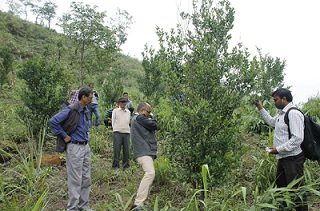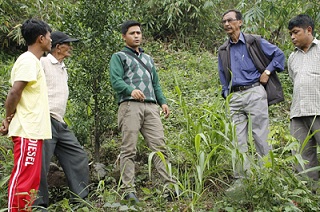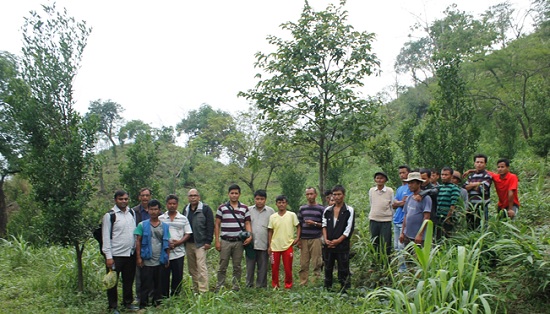Diagnostic field visit of Khasi mandarin orchards in Nongtrai village, East Khasi Hills village
A team of scientists (Dr. H. Rymbai, Dr. Pankaj Baiswar and Dr. D.M. Firake), ICAR Research Complex for NEH Region, visited Khasi mandarin orchards of Nongtrai village on 18th April, 2016. The site is located about 97 km from Umiam. The purpose of the visit was to know the orchard conditions which is maintaining by the Special Purpose Vehicle Society, Shillong and Lafarge India Pvt. LTD under Public-private partnership mode. It was observed that most of the residents in the village have minimum 2-5 Khasi mandarin plants per household, while few orchards are of acres in size.
The major finding is poor orchard maintenance and lacking of Good Horticulture Practices among the farmers. There is Lack of training and pruning in Khasi mandarin plants. The plants are never given any care regarding training and pruning. Plants have become bushy with multiple stems. This is because all the shoots/ suckers sprouted are allowed to grow. Furthermore, even the disease infected branches were not pruned from the tree. It is recommended that during the first year, all branches growing below 70 cm below the ground must be removed. The stem must be kept clean and straight with 4-5 well arranged branches in all direction of the tree. All the undesirable branches including water suckers emerged from the seedling and rootstock should be frequently removed as and when appeared in the tree. In bearing trees, pruning is required to remove undesirable growth such as water shoots, criss-crossed, dried, diseased branches. This should be carried out once in a year after harvesting of fruits during December-January. The cut end portion of pruned part must be pasted with Bordeaux paste (in case not available, simply past with cowdung).
There is no fertilizers and manures application adopted by the farmers. The orchards are never given any fertilizer and manure application since planting time. Moreover, the orchards are located in the hill and rocky slope with shallow soil. Therefore it is recommended that the following manure and fertilizers schedule may be followed in Khasi mandarin.
The time of manure and fertilizers application is June-July and September – October. Fertilizers and manure must be apply around the basin under the canopy of the tree, keeping 20-25 cm space from the main stem and mix by light hoeing. About 2-3 sprays of Zinc Sulphate (0.4%) + magnesium Sulphate (0.2%) + Copper Sulphate (0.3%) or Multiplex (mixture of multimicronutrient @ 0.25%) may also be given during flushing period. It is also recommended that weeds and other plant materials should not be burned (exception the disease and pest infested part); rather it must be disposed to compost pit for turning and use it as manures.
Seedling origin planting materials were used for planting throughout the village. It is recommendation that farmers are recommended to use only disease free grafted or budded planting materials, and procurement may be made from the recognized/ registered/ government nursery. In addition, organic mulching such as uses of dried straw/ grasses must be kept around the basin of the tree. This will conserve moisture and maintain the nutritional status of the soil. Half moon terraces which is less expensive compare to other terraces may also be adopted to minimize soil erosion during rainy season.
The diseases present are powdery mildew, die back and scab (but not in severe form). It is recommended that the following measures may be taken: 1) Protection of new flush is important using bordeaux mixture (1%). 2) Prune dead and diseased shoots and use Bordeaux paste to protect cut ends. 3) Bordeaux paste should be applied up to a height of 60 cm (Dec-Jan, Jun-July) on trunk. 4) Follow double ring method for basin preparation to avoid direct contact of trunk with water.
Incidence of cottony cushion scale, Icerya spp., twig borer and fruit sucking bugs was observed in few trees. Based on the insect-pest observed following management practices may be followed; 1) Regular clipping and destruction of infested plant parts. 2) Spray of neem oil @2ml/litre with sticker or surfactant @0.5ml/litre, as and when infestation started. 3) Ant colonies in the orchard should be destroyed as they are the carrier of mealy bugs and scales to their feeding sites.
Furthermore, old orchards of about 35-40 years were also observed with low and unproductive. It is recommended to adopt rejuvenation technique in these old orchards.
Team Members Visited The Site:
- Dr. H. Rymbai (Scientist, Horticulture)
- Dr. Pankaj Baiswar (Senior Scientist Plant Pathology)
- Dr. D.M. Firake (Scientist, Entomology)



